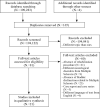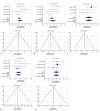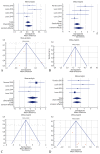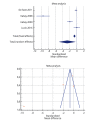Management of bladder dysfunction in multiple sclerosis: a systematic review and meta-analysis of studies regarding bladder rehabilitation
- PMID: 35102733
- PMCID: PMC9980558
- DOI: 10.23736/S1973-9087.22.07217-3
Management of bladder dysfunction in multiple sclerosis: a systematic review and meta-analysis of studies regarding bladder rehabilitation
Abstract
Introduction: The aim of the study was to investigate the efficacy of rehabilitation programs for bladder disorders in patients with multiple sclerosis (MS) and to guide physicians in delineating therapeutic tools and programs for physiatrists, using the best current strategies.
Evidence acquisition: A search was conducted on PubMed, EMBASE, the Cochrane Library and Web of Science. Studies were eligible if they included adults with bladder disorders related to MS and described specific treatments of rehabilitation interest. The search identified 190,283 articles using the key words "multiple sclerosis" AND "rehabilitation" AND "urinary" OR "bladder," of which the reviewers analyzed 81 full-texts; 21 publications met the criteria and were included in the systematic review.
Evidence synthesis: The systematic review identified the specific rehabilitation treatments reported in the current literature. The meta-analysis compared the scores and scales used to quantify bladder disorders due to MS, both before and after rehabilitation or in a comparison with a control group.
Conclusions: The present study suggests the need of a specific therapeutic protocol, based on the degree of disability and symptom complexity in patients with MS-related neurogenic lower urinary tract dysfunction (NLUTD). Particularly, the meta-analysis shows the effectiveness of peripheral tibial nerve stimulation (PTNS) and pelvic floor muscle training (PFMT) for neurogenic detrusor overactivity (NDO). However, the goal of physiotherapy is to treat incontinence without making urinary retention worse and vice-versa, reducing the loss of urine urgency, while ensuring the emptying of the bladder.
Conflict of interest statement
Figures




Similar articles
-
Posterior tibial nerve stimulation as a neuromodulation therapy in treatment of neurogenic overactive bladder in multiple sclerosis: A prospective randomized controlled study.Mult Scler Relat Disord. 2022 Dec;68:104252. doi: 10.1016/j.msard.2022.104252. Epub 2022 Oct 17. Mult Scler Relat Disord. 2022. PMID: 36274285 Clinical Trial.
-
[Physiotherapy and neurogenic lower urinary tract dysfunction in multiple sclerosis patients: a randomized controlled trial].Prog Urol. 2014 Sep;24(11):697-707. doi: 10.1016/j.purol.2014.05.003. Epub 2014 Jun 19. Prog Urol. 2014. PMID: 25214451 Clinical Trial. French.
-
Evaluating the effects of transcutaneous tibial nerve stimulation or pelvic floor muscle training on sexual dysfunction in female multiple sclerosis patients reporting overactive bladder.Neurourol Urodyn. 2021 Aug;40(6):1661-1669. doi: 10.1002/nau.24733. Epub 2021 Jun 26. Neurourol Urodyn. 2021. PMID: 34174117
-
Effects of posterior tibial nerve stimulation (PTNS) on lower urinary tract dysfunction: An umbrella review.Neurourol Urodyn. 2024 Feb;43(2):494-515. doi: 10.1002/nau.25343. Epub 2023 Dec 28. Neurourol Urodyn. 2024. PMID: 38153131
-
Efficacy of peripheral electrical nerve stimulation on improvements of urodynamics and voiding diary in patients with neurogenic lower urinary tract dysfunction: a systematic review and meta-analysis.Int J Surg. 2023 May 1;109(5):1342-1349. doi: 10.1097/JS9.0000000000000168. Int J Surg. 2023. PMID: 37026834 Free PMC article.
Cited by
-
The Prevalence and Impact of Urinary Incontinence on Multiple Sclerosis Patients in Taif City, Saudi Arabia.Cureus. 2024 Mar 26;16(3):e57010. doi: 10.7759/cureus.57010. eCollection 2024 Mar. Cureus. 2024. PMID: 38681390 Free PMC article.
-
Urethral bulking agents and pelvic floor muscle training for the treatment of stress urinary incontinence in female patients with multiple sclerosis.Bladder (San Franc). 2025 Jan 17;11(4):e21200028. doi: 10.14440/bladder.2024.0049. eCollection 2024. Bladder (San Franc). 2025. PMID: 39944513 Free PMC article.
-
Special Issue: "Latest Advances on Urinary Incontinence".J Clin Med. 2023 Nov 14;12(22):7075. doi: 10.3390/jcm12227075. J Clin Med. 2023. PMID: 38002688 Free PMC article.
-
Effects of repetitive functional magnetic stimulation in the sacral nerve in patients with neurogenic detrusor overactivity after suprasacral spinal cord injury: a study protocol for a randomized controlled trial.Trials. 2023 Mar 17;24(1):199. doi: 10.1186/s13063-023-07207-1. Trials. 2023. PMID: 36932375 Free PMC article.
-
The Efficiency of Rehabilitation Therapy in Patients Diagnosed with Neurogenic Bladder: A Systematic Review.Medicina (Kaunas). 2024 Jul 17;60(7):1152. doi: 10.3390/medicina60071152. Medicina (Kaunas). 2024. PMID: 39064583 Free PMC article.
References
-
- European Multiple Sclerosis Platform. Recommendations on rehabilitation services for persons with multiple sclerosis in Europe. Brussels: EMSP; 2004.
-
- Amarenco G, de Sèze M, Ruffion A, Sheikh Ismael S. Clinical and urodynamic evaluations of urinary disorders in multiple sclerosis. Ann Phys Rehabil Med 2014;57:277–87. https://www.ncbi.nlm.nih.gov/entrez/query.fcgi?cmd=Retrieve&db=PubMed&l... 10.1016/j.rehab.2014.05.006 - DOI - PubMed
-
- Al Dandan HB, Coote S, McClurg D. Prevalence of Lower Urinary Tract Symptoms in People with Multiple Sclerosis: A Systematic Review and Meta-analysis. Int J MS Care 2020;22:91–9. https://www.ncbi.nlm.nih.gov/entrez/query.fcgi?cmd=Retrieve&db=PubMed&l... 10.7224/1537-2073.2019-030 - DOI - PMC - PubMed
-
- de Sèze M, Ruffion A, Denys P, Joseph PA, Perrouin-Verbe B; GENULF. The neurogenic bladder in multiple sclerosis: review of the literature and proposal of management guidelines. Mult Scler 2007;13:915–28. https://www.ncbi.nlm.nih.gov/entrez/query.fcgi?cmd=Retrieve&db=PubMed&l... 10.1177/1352458506075651 - DOI - PubMed
-
- Lúcio AC, Perissinoto MC, Natalin RA, Prudente A, Damasceno BP, D’ancona CA. A comparative study of pelvic floor muscle training in women with multiple sclerosis: its impact on lower urinary tract symptoms and quality of life. Clinics (São Paulo) 2011;66:1563–8. https://www.ncbi.nlm.nih.gov/entrez/query.fcgi?cmd=Retrieve&db=PubMed&l... 10.1590/S1807-59322011000900010 - DOI - PMC - PubMed
Publication types
MeSH terms
LinkOut - more resources
Full Text Sources
Medical
Miscellaneous

